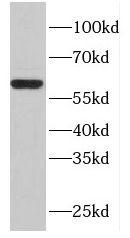Products
FBXW11 antibody
| Synonyms: | F-box/WD repeat-containing protein 11|F-box and WD repeats protein beta-TrCP2|F-box/WD repeat-containing protein 1B|Homologous to Slimb protein (HOS)|FBXW11|BTRCP2|FBW1B|FBXW1B|KIAA0696 antibody | ||
| Catalogue No.: | FNab03052 | Reactivity: | Human, Mouse, Rat |
| Host: | Rabbit | Tested Application: | ELISA, WB |
| Clonality: | polyclonal | Isotype: | IgG |
| Size | Price |
|---|---|
| 100µg | Inquiry |
- SPECIFICATIONS
- FIGURES
- CONDITIONS
- FAQS
- Product Name
- FBXW11 antibody
- Catalogue No.
- FNab03052
- Size
- 100μg
- Form
- liquid
- Purification
- Immunogen affinity purified
- Purity
- ≥95% as determined by SDS-PAGE
- Clonality
- polyclonal
- Isotype
- IgG
- Storage
- PBS with 0.02% sodium azide and 50% glycerol pH 7.3, -20℃ for 12 months(Avoid repeated freeze / thaw cycles.)
- Immunogen
- F-box and WD repeat domain containing 11
- Alternative Names
- F-box/WD repeat-containing protein 11|F-box and WD repeats protein beta-TrCP2|F-box/WD repeat-containing protein 1B|Homologous to Slimb protein (HOS)|FBXW11|BTRCP2|FBW1B|FBXW1B|KIAA0696 antibody
- UniProt ID
- Q9UKB1
- Observed MW
- 61 kDa
- Tested Applications
- ELISA, WB
- Recommended dilution
- WB: 1:500-1:2000
 SGC-7901 cells were subjected to SDS PAGE followed by western blot with FNab03052(FBXW11 antibody) at dilution of 1:2000
SGC-7901 cells were subjected to SDS PAGE followed by western blot with FNab03052(FBXW11 antibody) at dilution of 1:2000
- Background
- Substrate recognition component of a SCF(SKP1-CUL1-F-box protein) E3 ubiquitin-protein ligase complex which mediates the ubiquitination and subsequent proteasomal degradation of target proteins. Probably recognizes and binds to phosphorylated target proteins. SCF(FBXW11) mediates the ubiquitination of phosphorylated CTNNB1 and participates in Wnt signaling. SCF(FBXW11) mediates the ubiquitination of phosphorylated NFKBIA, which degradation frees the associated NFKB1 to translocate into the nucleus and to activate transcription. SCF(FBXW11) mediates the ubiquitination of IFNAR1. SCF(FBXW11) mediates the ubiquitination of CEP68; this is required for centriole separation during mitosis(PubMed:25503564). Involved in the oxidative stress-induced a ubiquitin-mediated decrease in RCAN1. Mediates the degradation of CDC25A induced by ionizing radiation in cells progressing through S phase and thus may function in the intra-S-phase checkpoint. Has an essential role in the control of the clock-dependent transcription via degradation of phosphorylated PER1 and phosphorylated PER2. Is target of human immunodeficiency virus type 1(HIV-1) protein VPU to polyubiquitinate and deplete BST2 from cells and antagonize its antiviral action.
How many times can antibodies be recycled?
First, usually it's not suggested to recycle antibodies. After use, buffer system of antibodies has changed. The storage condition of recycled antibodies for different customers also varies. Thus, the performance efficiency of recycled antibodies can’t be guaranteed. Besides, FineTest ever conducted the antibody recycling assay. Assay results show recycling times of different antibodies also varies. Usually, higher antibody titer allows more repeated use. Customers can determine based on experimental requirements.
Notes: After incubation, we recycle rest antibodies to centrifuge tube and store at 4℃. High titer antibodies can be stored for a minimum of one week. Reuse about three times.
What are components of FineTest antibody buffer?
Components of FineTest antibody buffer are usually PBS with proclin300 or sodium azide, BSA, 50% glycerol. Common preservative is proclin300 or sodium azide, which is widely applied in the lab and industry.
How about the storage temperature and duration of FineTest antibodies?
Most antibodies are stored at -20℃. Directly-labeled flow cytometry antibodies should be stored at 2 - 8℃. The shelf life is one year. If after sales issues for purchased antibodies appear, return or replacement is available. Usually, antibodies can be still used after the one-year warranty. We can offer technical support services.
Is dilution required for FineTest antibodies? What’s the dilute solution?
Directly-labeled flow cytometry antibodies are ready-to-use without dilution. Other antibodies are usually concentrated. Follow the dilution ratio suggested in the manual. Dilute solution for different experiments also varies. Common antibody dilution buffers are acceptable(e.g. PBST, TBST, antibody blocking buffer).
How to retrieve antibodies for immunohistochemistry?
Common retrieval buffers: Tris-EDTA Buffer(pH 9.0); Citrate Buffer(pH 6.0)
Heat induced antibody retrieval:
Method 1: Water-bath heating: Put the beaker with retrieval buffer and slide in the boiling water bath. Keep the boiling state for 15min. Naturally cool to room temperature;
Method 2: Microwave retrieval: Put the beaker with retrieval buffer and slide in the microwave oven. Heat at high power for 5min, Switch OFF for 3min, Heat at medium power for 5min. Naturally cool to room temperature.
How to choose secondary antibodies?
(1) Secondary antibodies react with primary antibodies. Thus, secondary antibodies should be against host species of primary antibodies. E.g. If the primary antibody is derived from rabbit, the relevant secondary antibody should be against rabbit. E.g. goat anti rabbit or donkey anti rabbit.
(2) Choose secondary antibody conjugates according to the experimental type, e.g. ELISA, WB, IHC etc. Common enzyme conjugated secondary antibodies are labelled by HRP, AP etc. Fluorescin or dye labelled secondary antibodies are applied in immunofluorescence and flow cytometry(e.g. FITC, Cy3).
